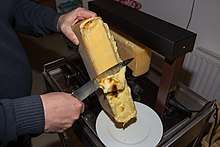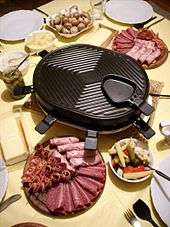Raclette
Raclette (/rəˈklɛt/) is a pungent semi-hard cheese that is usually fashioned into a wheel of about 6 kg (13 lb).[1] The Alpine cow milk based dairy product is most commonly used for melting, but is also consumed as a slice. Raclette also is a Swiss[2][3][4] dish, also very popular in Savoie (France), based on heating the cheese and scraping off (from French: racler) the melted part.
| Raclette | |
|---|---|
 | |
| Country of origin | Switzerland |
| Region, town | Les Alpes |
| Region | Swiss Alps |
| Source of milk | Cows |
| Pasteurised | No |
| Texture | semi-hard |
| Aging time | 3-6 months |
| Certification | AOC 2003-2013 AOP since 2013 |
History
Raclette was mentioned in medieval texts from Swiss convents dating from as early as 1291.[5] The cheese was originally consumed by peasants in the mountainous Alpine regions of the cantons of Valais and Fribourg (Switzerland), and Savoie and Haute-Savoie (France). It was then known in the German-speaking part of Switzerland as Bratchäs, or "roasted cheese". Traditionally, cow herders carried cheese with them when they were moving cows to or from pastures up in the mountains. In the evening, the cheese would be placed next to a campfire for softening, then scraped onto bread.
In Switzerland raclette is typically served with potatoes, cornichons, pickled onions, black tea, other warm beverages, or Fendant wine. A French popular option is to serve it with white wine, such as the traditional Savoy wine, but Riesling and pinot gris are also common. There is a persistent claim that consuming cold water with it leads to indigestion, but this has been disproven.[6]
In Switzerland, a scraper continuously serves all in the restaurant from an oven placed in a separated table or near a wood fire. In France, restaurateurs often place a raclette oven directly on the table. In that case, the scraping is to be done by the guests.
Dish

Raclette is a dish indigenous to parts of Switzerland. The raclette cheese round is heated, either in front of a fire or by a special machine, then scraped onto diners' plates.[7]
Traditionally the melting happens in front of an open fire, with the big piece of cheese facing the heat. One then regularly scrapes off the melting side. It is accompanied by small firm potatoes (Bintje, Charlotte or Raclette varieties), cornichons (gherkins), pickled onions, and dried meat, such as jambon cru/cuit, salami, and viande des Grisons, and to drink, Kirsch, black or herbal tea or white wine from a Valais vineyard (a Fendant wine from the Chasselas grape).
A modern way of serving raclette involves an electric table-top grill with small pans, known as coupelles, in which to melt slices of raclette cheese. This new way has been used since the 1950s. Generally the grill is surmounted by a hot plate or griddle. In Switzerland the electrical raclette is called "raclonette". The device is put in the middle of the table. The cheese is brought to the table sliced, accompanied by platters of boiled or steamed potatoes, other vegetables and charcuterie. These are then mixed with potatoes and topped with cheese in the small wedge-shaped coupelles that are placed under the grill to melt and brown the cheese. Alternatively, slices of cheese may be melted and simply poured over food on the plate. The emphasis in raclette dining is on relaxed and sociable eating and drinking, the meal often running to several hours. French and other European supermarkets generally stock both the grill apparatus and ready-sliced cheese and charcuterie selections, especially around Christmas. Restaurants also provide raclette evenings for parties or dinners.
Raclette cheese is native from Valais and benefits from PDO. Today raclette is made in various regions and countries of the world, including Switzerland, France (Savoy, Franche-Comté, Auvergne, Brittany), Luxembourg, Austria, Germany, Finland, Australia, Canada and the United States.
The "vercouline" is a raclette in which Bleu du Vercors-Sassenage is used. In Franche-Comté, the Bleu de Gex (or "Bleu du Haut Jura) and Morbier, both PDO are used as variants.
See also
- Appellation d'origine protégée (Switzerland)
- Culinary Heritage of Switzerland
- Fondue, a different Swiss dish based on cheese melted in a pot
References
- Dominik Sauerländer, Anne-Marie Dubler: Käse in German, French and Italian in the online Historical Dictionary of Switzerland, 5 February 2018.
- "Raclette". MySwitzerland.com. Retrieved 2019-01-08.
- "Raclette". BBC Food. Retrieved 2019-01-08.
- "Switzerland - Daily life and social customs". Encyclopedia Britannica. Retrieved 2019-01-08.
- "La raclette". Raclette-suisse.ch. Archived from the original on 2013-12-03.
- "Zurich study settles longstanding fondue beverage debate". dw.com. Retrieved 30 June 2020.
- "Raclette – another classic for cooking with fire". Texas Oven Co. Retrieved 23 October 2019.